written and photographed by Mary L. Peachin
Apr 1998, Vol. 2 No. 7
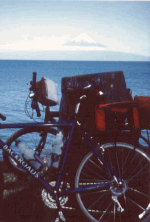 Bariloche is the destination of anglers’ dreams. Virgin streams offer world-class fly fishing for rainbow and brown trout. Searching my wish-list file of future adventures, I found an October ’96 Forbes article about an Argentinean estancia, Arroyo Verde, titled “The World’s Best Fly Fishing Lodge. Period!” A second article went on to entice: I could join the Backroads 11-day bicycle tour, ride 285 miles through the Andes from Puerto Montt, Chile to Bariloche, Patagonia, Argentina, then relax in the luxury of Arroyo Verde, indulging in fly fishing and horseback riding to my heart’s content.
Bariloche is the destination of anglers’ dreams. Virgin streams offer world-class fly fishing for rainbow and brown trout. Searching my wish-list file of future adventures, I found an October ’96 Forbes article about an Argentinean estancia, Arroyo Verde, titled “The World’s Best Fly Fishing Lodge. Period!” A second article went on to entice: I could join the Backroads 11-day bicycle tour, ride 285 miles through the Andes from Puerto Montt, Chile to Bariloche, Patagonia, Argentina, then relax in the luxury of Arroyo Verde, indulging in fly fishing and horseback riding to my heart’s content.
Chile, bordered on the east by the Andean mountain range, has never been considered much of a tourist destination. All I knew about travel in the region was that serious mountain climbers go to Chile to climb Mount Aconcaqua (23,080 ft), the highest summit in the Western hemisphere. To put it mildly, the Andes seemed an unlikely area to tour on a bicycle.
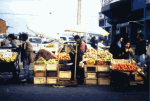 I did some more research. The Backroads Active Travel brochure rated the bicycle trip good for “energetic beginners, who might require an occasional van shuttle,” plus intermediate and advanced riders. The terrain was defined as “mostly rolling with some level riding and some long grades.” There was also mention of “sapphire-blue lakes curving around the feet of snow-crowned volcanoes and the rugged Andes.”
I did some more research. The Backroads Active Travel brochure rated the bicycle trip good for “energetic beginners, who might require an occasional van shuttle,” plus intermediate and advanced riders. The terrain was defined as “mostly rolling with some level riding and some long grades.” There was also mention of “sapphire-blue lakes curving around the feet of snow-crowned volcanoes and the rugged Andes.”
That’s it; I was hooked. What I didn’t know was that the bicycle portion of my trip would prove as interesting and memorable as the fishing that had drawn me to Chile in the first place.
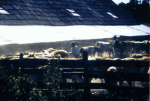 American Airlines flies nonstop from Miami to Santiago, Chile. The sunrise aerial view of the snow-capped Andes told me I was in Chile, and our plane soon dipped down, landing in Santiago.
American Airlines flies nonstop from Miami to Santiago, Chile. The sunrise aerial view of the snow-capped Andes told me I was in Chile, and our plane soon dipped down, landing in Santiago.
I was surprised by the charm of Santiago, and of the Carrera Hotel, soon regretting that I was spending only one day there. The sounds of a military band on the plaza below interrupted my quick morning nap-a good thing, as I was fashionably late for a two PM lunch at a local parrillada restaurant, El Novillero.
At the restaurant, customers, mostly men in coat and tie, cooked steak or chicken on small grills (parrilladas) next to their tables. It was clear that I was in South America, home of the meat meal. After lunch I wandered down the cobblestone streets of the financial district. Businesspeople scurried from one great marble office tower to another, talking intently on their mobile phones. When I strayed from the business district to walk through a local market, a pair of policemen kindly approached me, expressing their concern that someone might want to take my camera. They escorted me back in the direction of my hotel.
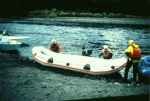 A six a.m. wake-up knock on my door at the Carrera gave me an hour to catch a shuttle to the Arturo Merino Benitez national airport. An hour later, the Ladeco Airline jet arrived in Puerto Montt, where I settled into the 25-room Hotel Viento Sur. The next day, I would meet the other eighteen riders on the Backroads tour. I spent the extra day visiting Chiloe, a small southern port city overlooking the Gulf of Reloncavi in the Pacific Ocean.
A six a.m. wake-up knock on my door at the Carrera gave me an hour to catch a shuttle to the Arturo Merino Benitez national airport. An hour later, the Ladeco Airline jet arrived in Puerto Montt, where I settled into the 25-room Hotel Viento Sur. The next day, I would meet the other eighteen riders on the Backroads tour. I spent the extra day visiting Chiloe, a small southern port city overlooking the Gulf of Reloncavi in the Pacific Ocean.
Meeting on the lawn of the Hotel Viento Sur, Backroads guides Suzie Raleigh and Shannon Scott offered safety tips for the ride. The eighteen riders in our group included white-collar workers, software technicians, and one student, ranging in ages from mid-20s to 60s. We introduced ourselves, then suited up and began our ride.
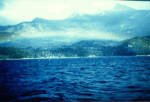 The route began on a dirt road along the north shore of Lago Llanquihue, the third largest lake in South America. The autumn sun of that fall day illuminated captivating views of the snow-clad Osorno and Calbuco volcanoes, which are often obscured by clouds.
The route began on a dirt road along the north shore of Lago Llanquihue, the third largest lake in South America. The autumn sun of that fall day illuminated captivating views of the snow-clad Osorno and Calbuco volcanoes, which are often obscured by clouds.
We were soon guiding our wide-tread mountain bikes along rolling (and sometimes steep) gravel roads. Mountain bikes require more effort than smooth-tread touring, or road, bikes. In many places, lava-rock gravel (used to provide the fill for potholes as an alternative to grading Chilean roads) made the ride slippery and challenging.
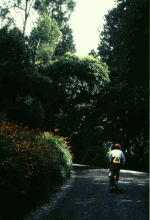 Our first two nights were spent in the villages of Frutillar and Ensenada, both settled in the mid-1800s by German immigrants. While the German architecture of the villages is preserved, the people have been fully assimilated into the culture of Chile. The scenic lakefront Hotel Salzburg in Frutillar was a welcome sight after the first 30 miles spent bumping over ungraded, washboard-textured roads. The Hotel Ensenada, 53 miles farther in Parque Nacional Vicente Perez Rosales at the base of the Osorno volcano, is a hiking destination for many Chileans.
Our first two nights were spent in the villages of Frutillar and Ensenada, both settled in the mid-1800s by German immigrants. While the German architecture of the villages is preserved, the people have been fully assimilated into the culture of Chile. The scenic lakefront Hotel Salzburg in Frutillar was a welcome sight after the first 30 miles spent bumping over ungraded, washboard-textured roads. The Hotel Ensenada, 53 miles farther in Parque Nacional Vicente Perez Rosales at the base of the Osorno volcano, is a hiking destination for many Chileans.
The next day’s journey was a short 10 miles to Petrohue. By this time, our group had bonded enough to make the decision to share the cost of a half-day river-rafting trip down the Petrohue River. “Adelante! Vamos! Alto!” Row, hurry, stop! Our rowing lesson came in Spanish. It was a fun and relaxing afternoon, a nice break from the bicycle saddle.
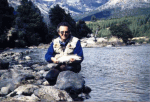 After this break, the day came to cross the Andes. At our morning briefing, we learned that Suzie would carry our bicycles on top of the van; it would take her 10 hours to cross the Andes at 12,000 feet. The rest of us would take the Cruce Internacional Lagos Andinos, a daylong journey by ferry and bus through the Lagos Todos los Santos.
After this break, the day came to cross the Andes. At our morning briefing, we learned that Suzie would carry our bicycles on top of the van; it would take her 10 hours to cross the Andes at 12,000 feet. The rest of us would take the Cruce Internacional Lagos Andinos, a daylong journey by ferry and bus through the Lagos Todos los Santos.
What a relief! Our scenic ride through lakes and forest named in honor of “all of the saints,” as one rider joked, was a welcome alternative to an uphill grunt over the Andes.
Several hours later, we crossed from the Chilean national park of Perez Rosales into the Argentine Parque Nacional Nahuel Huapi. We were amazed how well the two countries coordinated the ferry and bus journey, without delays and without losing our luggage. It was the first rainy day of our trip, yet through numerous transfers, our luggage remained dry.
A layover day at the Llao Llao resort, where we rejoined our bikes, allowed us to ride the popular “Circuito Chico” route, a 33-mile ride through rainforest that passes several lakes. The highest scenic lookout, Punta Panoramico, features a view of Mount Tronodor (11,520 ft), the highest Andean peak of the region.
From Parque Nacional Los Arrayanes, it was a 12-mile pedal to Villa La Angostura, along the Arrayanes Trail. The arrayanes is a native tree with peeling bark that resembles cinnamon; its leaves look like myrtle. The trail required some technical mountain biking expertise and, as a result, there was a lot of walking bikes around roots and under low branches. Where the trail washed into Lake Nahuel Huapi, we had to edge along the side of the lake, walking our bikes. The van shuttle couldn’t follow along on this two-to-three hour ride.
By this time, our group was beginning to show some “battle scars;” at one time or another just about everyone hit the ground. We were looking forward to another layover day after a 37-mile ride to Villa Traful.
We found it at the beautiful Hosteria la Posada in Villa La Angostura, overlooking Lake Espejo. The hotel is frequented in the winter (our summer) by South Americans skiing the well-known Cerra Bayo ski basin. Our fall visit provided a picturesque view of the hotel’s terraced gardens, which included lavender, poppies, roses, and many other flowers. I found the charm of this 20-room hotel preferable to the “luxury” of the Llao Llao resort.
The small village of Traful included a newly built lakefront pier, chocolate factory, police station, forest fire commissioner, two small stores, and the fishing lodge where we stayed: El Rincon del Pescador. On our layover day, most riders headed for the chocolate factory, while others took an energetic hike around Lago Traful.
It was hard to believe that our final day, a 62-mile ride into the town of San Carlos de Bariloche, could offer more scenic enticements than had the previous 10 days, but it did. Rocky spires combined with colorful sandstone and flagstone to create scenery like a combination of majestic Bryce and Zion national parks.
After the last 25 miles, a dirt road along the Rio Traful, we arrived at the paved highway leading to San Carlos de Bariloche. About this time, the strong Pampas headwinds began to blow as the skies darkened-as though Mother Nature knew our tour was coming to an end. Just as I approached that little yellow road sign, the one with a drawing of a car going uphill , the Backroads van pulled along beside me. With a sigh of relief, I climbed into the van with the other riders as a torrential rain began. It was perfect timing, a fine end to a challenging and rewarding trip.
